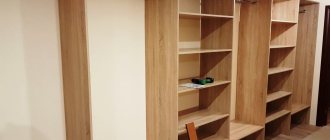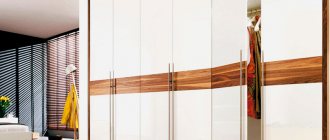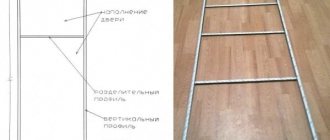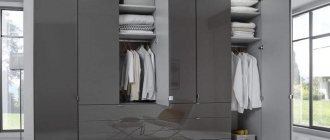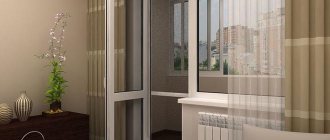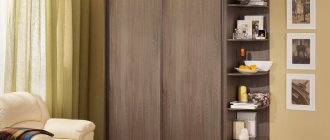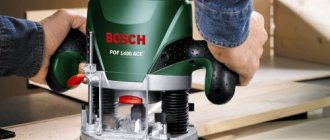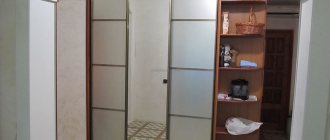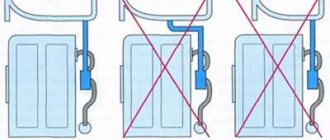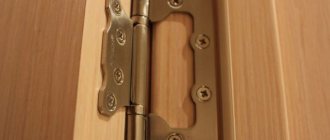Door distortions, their loose fit, difficulties with opening/closing - there are quite a lot of problems typical not only for new furniture after its assembly is completed, but also for old ones. First of all, this applies to elements of kitchen units, the awnings of which are affected by changes in humidity, temperature, and their high values. As a rule, most defects that appear can be eliminated by adjusting the hinges on cabinet doors. And the services of a specialist, if you understand the meaning of all operations, are definitely not needed.
All a home craftsman needs is a cross-head screwdriver, since the awnings are fastened with self-tapping screws. And, of course, an understanding of what needs to be done.
When is adjustment needed?
Adjusting the hinges, first of all, may be necessary immediately after purchasing the cabinet.
After installing it, you should check the strength of the hinges, whether the doors are securely fastened, whether they close correctly, and if defects are detected, correct them immediately.
The same procedure is carried out after moving from one place of residence to another. During transportation, the doors may become deformed and they may become loose, so after transporting the furniture, you may have to adjust the hinges.
Well, at home, you should periodically check how well the cabinets close and whether the doors are loose: malfunction of the canopies can be associated with sudden changes in temperature, constant humidity, or incorrect actions during operation.
What will you need?
The main tools when adjusting door hinges are a regular and Phillips screwdriver. Sometimes you may need a plumb line or level for construction work, with the help of which you need to find out how level the structures are.
Distortions may be due to the fact that the cabinet was assembled incorrectly or placed on an uneven surface.
For such cases, you need a plumb line - it will help the master determine the geometry of the structure and, if necessary, level it. As a rule, after such manipulations there is no need to adjust the hinges, the curvature is eliminated, everything falls into place.
Further work will require an understanding of what needs to be done. First, you need to identify the scale of the problem and decide on the method of adjustment. When inspecting the awnings, a loose fastening may be discovered - in this case, we are not talking about adjustment, you just need to tighten the screws more tightly.
It is necessary to consider the location of the gap, estimate the size, radius of displacement and designate the area of the hook. These are mandatory rules that must be followed before getting down to business. They will help you understand how to make adjustments: by width (when an uneven gap between the blades is visible), depth or height (when one blade is located lower or higher relative to the other).
How to adjust hinges on cabinet doors: technique
Often new furniture loses its attractive appearance due to the fact that their geometry is disrupted by inclined doors. But old wardrobes with heavy doors, where even the grooves for fastening the screws are worn out...
One conclusion suggests itself: it needs repairs and adjustments. You can do it yourself. So I’m telling you how to adjust the hinges of the cabinet doors, restore the normal operation of the cabinet, its original appearance.
Check out this simple technique and give us your opinion.
Types of hinge adjustment
Before you start adjusting furniture hinges, you need to determine the cause of the misalignment. This can be done as follows:
- Check that the cabinet is assembled and installed correctly. If there is misalignment, adjusting the awnings may not be useful. First you need to determine what caused the displacement - different heights of the floor or legs, incorrect assembly, etc. It is better to level the furniture structure using a special construction or plumb line.
- Inspect the hinges themselves. This way you can determine the type and condition of the awnings. Without this, it is impossible to choose a solution, since repairing each type of mechanism requires certain types of work. If the problem is that the hinges are loose, just tighten them with a screwdriver.
- Determine the type of adjustment required. It is important to detect the location of the gaps, their size, radius of curvature, and the area where the blade catches. Knowing the “scale” of the problem, you can choose a way to adjust the canopies: height, depth or width.
Adjusting facades in planes
Before adjusting the hinges on the cabinet door leaves, you need to decide on what principle the work will be performed. There are several types of regulation:
Hidden
They are called 3D loops. Hidden loops are distinguished into:
- Adjustable;
- Unregulated.
To repair an adjustable hidden hinge:
- Remove all covers hiding the screws;
- Using the key that comes with the hinge, loosen the necessary screws to align the door height, along the gap between the door frame or horizontally;
- Align the door;
- Secure the door leaf by screwing the screws back.
The instructions for hidden hinges contain an illustration of the rules of use. It clearly shows the bolts and what parameter of the door they are aimed at regulating.
Non-adjustable hinges are made from strong materials and are distinguished by their reliability. But they are not subject to any type of adjustment. If a hidden non-adjustable hinge breaks, you must buy a new one.
Possible problems
Installing sliding doors in a wardrobe is one of the most difficult moments when assembling this piece of furniture. It is these components that tend to periodically break or become deformed as a result of improper installation or subsequent careless handling. Even those owners who used the cabinet very carefully sooner or later may encounter phenomena such as:
- lack of smoothness;
- skewed door leaf;
- lack of door locking when closing;
- peeling off the buffer tape
- the web jumping off the guide track;
- the appearance of extraneous sounds.
Common faults
The sliding wardrobe system includes one or more doors. They move along the guides using rollers that are attached at the bottom or top.
To ensure that the doors do not hit and close completely when opening and closing, the design provides for the use of a stopper and a closer.
The main reason why vertical, height adjustment or correction of other problems may be required is long-term operation. Don’t forget about initially incorrect installation or the use of low-quality fittings.
Most often, owners of wardrobes encounter the following problems:
- over time the door sags;
- the stoppers are worn out or displaced, and therefore the door does not lock;
- the gap between the doors has increased and the doors are skewed;
- the door simply dangles and flies off the guides;
- the canvas does not move well along the guides, it moves slowly;
- Uncharacteristic extraneous sounds appeared during the opening and closing process;
- the connection has become loose, etc.
You can clearly see that there are quite a lot of problems and malfunctions. The costs for a specialist in such a situation will be impressive. Therefore, sometimes it makes sense to learn how to fix problems with your own hands.
Yes, you may need to purchase a special wrench that is used to adjust and install the stops on the coupe. But believe me, if the door falls off, they will charge a lot of money for repairs. In addition, the scheme for independently restoring the functionality of a sliding wardrobe is quite simple. You can master it by reading this material and watching various videos. On them you will see how cabinets with bottom and top rollers are repaired, and much more.
What distortions occur at the doors?
A three-dimensional coordinate system allows you to represent the deviation of the door from its normal position in space in relation to the original surface of the furniture.
It is convenient to take the front plane formed by the furniture box, from the walls, bottom and lid, as a basic reading. It is generally accepted that a door may deviate from its ideal state when:
- simply turned in the frontal plane to one side;
- it moved up or down;
- tilts backward relative to the horizon or vertical axis.
In fact, all three deviations are created in a complex way. It's just that one of them is more pronounced.
All these movements must be assessed by visual inspection before adjustment begins. The condition should be analyzed in the two extreme positions of the door:
- Locked down;
- Open.
You should always take into account that the door is attached not to one, but to two or three hinges.
it is necessary to change the position of the sash by alternately adjusting the screws on the upper and lower hinges. If the door is fixed with three curtains, then the middle part is simply loosened for the duration of the adjustment, then fixed in the new position.
How to setup?
You should start with the vertical adjustment of the canopy: find the upper and lower hinges on it, remove the plugs, if any. After that, use a screwdriver to loosen the screws and fix the cabinet doors to the desired position, raising or lowering them to the desired position.
The bolts are tightened, holding the blade at the optimal level. After the door leaves have been adjusted vertically, work begins in depth and horizontally. If you go from the opposite direction, you will still have to return to this sequence, so there is no need to waste time.
To adjust the height of the hinged cabinet doors and eliminate the friction of the panels on the lower slats, you need to loosen the screws mounted on two elongated ears with a screwdriver and make sure that the door does not warp.
If necessary, lift the front door and tighten the screws: use a screwdriver carefully, feeling the thread so as not to break it.
The depth of the hinges is adjusted when one of the panels moves away or the doors diverge in opposite directions. For such work you need a cross screwdriver. Tighten the adjusting screw towards you until the door is completely leveled: if 2-3 mm is not enough, continue the action.
In this case, this adjusting screw is turned well, it is pressed in more than the others, since it supports the main part of the structure. The main thing is to prevent the formation of gaps and cracks between the canvases.
This work requires patience. You may have to try on the sash several times to get the desired result, but this should not irritate you - experience will come with time.
Regardless of the method, there are general rules that must be followed when adjusting a cabinet door.
- Act clearly and consistently - this way you will be able to do everything faster and make fewer mistakes. First, adjustment is made in height, and then in relation to other canvases.
- You need to make sure that the structure is level. If there is a distortion in the geometry, first correct this point in order to understand: you need to work further or the problem has disappeared as a result of the correct installation of the furniture.
- It is also worth taking into account such a point as excessive crowding of the closet (typical of a wardrobe) - in this case, the gap between the door leaves will increase. But there is an acceptable norm - the size of the gap should not be more than 5 millimeters.
- There are cases when you first need to adjust the hinges, and only then start adjusting the doors. In this case, the facade additive under the cup is checked or identified during inspection.
Operating procedure
It should be noted that the first time you may not get the desired result. And this depends not only on the qualifications of the master. Many malfunctions are caused by several reasons, each of which entails certain negative consequences for the correct opening/closing of doors and their position on the cabinet facade. Therefore, adjustment is often carried out comprehensively, along several axes.
By height
This is necessary in case of obvious distortion. It begins to touch the bottom or top of the cabinet partitions with its upper cut; difficulties arise with closing tightly, since adjacent doors literally rest against each other with the ends of the panels.
In most types of hinges, the screw, which is responsible for the vertical displacement of the blade, is located in a round rather than an oblong hole, stretched in the form of an ellipse. It is always located closer to the sash.
When determining how to adjust cabinet doors, you need to consider that their position is affected by both canopies. It is necessary to loosen the fasteners, move the blade, tighten the screws slightly and check for opening/closing. As a rule, two or three attempts are enough, and the deficiency is eliminated.
Width (depth)
Here you will have to “work” with another screw. It is easy to determine by its installation location - it is further from the edge of the section, and the landing “window” has an oblong shape. This is what allows you to find the optimal position of the hinge relative to the wall of a kitchen or other cabinet. The fastener becomes loose and the moving part of the canopy either moves inward or is pulled out. The adjustment range is determined by the length of the “window” in which the screw is located.
The technique is identical: loosening the adjusting element - changing the position of the door - tightening the fasteners - assessing the result of the work. But in this case, you will have to screw in/unscrew both screws (both the far and the near), otherwise the hinge simply will not budge.
The question of how to adjust cabinet doors equipped with a closer also does not seem difficult. As a rule, this is necessary if there is a loose fit or slow closing (increased inertia). Such mechanisms differ only in the specifics of installation (on the hinges, between them), but their “tuning” is carried out according to a single algorithm. It all comes down to changing the position of the screw, which affects the intensity of movement of the spring. During the regulation process, it is weakened or tightened.
Adjusting the hinges is not done at once, and there is no need for haste; This kind of work requires extra attention. To install the sash in the desired position, you will have to perform several, sometimes identical, operations. But each of them is an experience, and therefore it will take much less time to eliminate the distortions of the second and third doors.
Installation process
First of all, you should install awnings on your kitchen cabinet. This process is not complicated. If the rear wall of the module is made of fiberboard, then it is necessary to cut two small holes in it for the mounting tabs. After this, press the canopy against the top panel of the cabinet and secure it with two self-tapping screws to the side wall.
If the back panel is made of laminated chipboard, then you will have to make a cutout directly under the canopy and fix it flush with the laminate. But this option is quite rare.
To mount a metal rail for hanging cabinets on the wall, you must perform the following calculations:
- Add up the height of the lower cabinets, the distance between the wall and floor modules, and the height of the upper cabinets. For example: 920+600+600 (pedestals, apron, top module).
- From the resulting result, 45 mm should be subtracted for the shrinkage of the canopy. The result will be a size that should be marked on the wall.
- Next, you need to mark a horizontal line along the level and attach a metal strip. It has holes for fastenings every 15-20 mm, but you don’t need to drill all of them, just fasten the screws in the corners of the mounted modules.
To make adjusting the cabinets easier, before installation, you should slightly loosen the fastening tab and allow it to move freely up and down. After this, you can begin hanging the cabinets, and then adjust them on the wall so that all modules hang evenly. The hanging elements can be fastened together with intersectional ties for strength and convenience.
Installing a kitchen yourself is not as difficult a process as it might seem. First of all, it is important to decide on the fastening, and if preference is given to canopies and planks, then installation can actually be carried out alone, without outside help. Before installation, it is necessary to complete all repair work and finish the walls in the kitchen, as well as prepare the necessary tools. It would be a good idea to familiarize yourself with the installation process in advance by watching video tutorials on the Internet.
How to set up correctly: step-by-step instructions
Before correcting defects in door panels on furniture, you must:
- Look at the piece of furniture when closed and assess the degree of distortion of the doors. The cabinet must stand on a perfectly flat surface.
- All things that may interfere with work are removed from the shelves to open access to the hinges.
- Inside the cabinet, a level is used to check the evenness of the walls and floor.
- Since some hinges have latches, you will need to have a flat or shaped screwdriver ready for the job.
Depending on the problems with the door leaf, a method for eliminating it is selected: horizontal, vertical or height alignment (these methods were discussed in detail above). But regardless of the adjustment method, there are several standard rules:
- Before work, furniture is set strictly according to level.
- First, the door leaf is leveled in height.
- If this does not help, proceed to leveling with the second screw.
Features for Ikea furniture hinges
Ikea furniture is of impeccable quality, but even on it, cabinet doors can warp and stop working properly. You can fix everything yourself if you figure out how to change the position of the door panels using screws (there are 3 of them on Ikea cabinets):
- If the doors begin to rub against the top or bottom of the body, it is necessary to adjust screw No. 1, which is responsible for the correct horizontal position of the doors. It turns clockwise and the door drops down. If the blade needs to be raised up, the screw rotates counterclockwise.
- If the doors no longer close tightly, and gaps appear between them. The second screw is adjustable, which is responsible for the depth.
- If the blades diverge in height, screws No. 3 are pressed out, and the blade is raised or lowered to the desired level.
Why else might the door not close?
Modern furniture has functional hinges.
What can cause tilting of the swinging sashes:
- This disease most often occurs with the kitchen door under the sink. This is facilitated, first of all, by frequent opening and closing, possibly with a bang. Secondly, moisture causes the door material to swell, deform and weaken the hinges. It is necessary to re-adjust the hinges according to the method described above; in a critical situation, the sash will need to be replaced.
- Young children can have a ride on the cabinet door, from which it slides down naturally. Supervise children and explain that such games cause costly property damage.
- The tight fit of furniture frames, such as kitchen cabinets, to the wall leads to friction between adjacent doors, which ends in bending of the hinges. In this case, adjustment may not help. To prevent this from happening, when hanging cabinets, you must leave a small gap between adjacent sides of the cabinets.
- Sash tilts may occur due to uneven surfaces on which the furniture is installed. The disadvantage is eliminated by leveling using pads of different thicknesses under the base.
Take a few minutes to adjust the buttonholes.
By spending a few minutes adjusting furniture hinges and combating door deformation, you will get an impeccable appearance of the facade, satisfaction from a job well done, and will extend the service life of the awnings for a long time.
There are many interesting hinge shapes on the market today.
How to attach adjustable attachments?
To attach kitchen cabinet hangers, you will need the following tools:
- Drill or hammer drill (depending on the wall material).
- Screwdriver or Phillips screwdriver.
- Hacksaw for metal.
- Level.
- Roulette.
Before proceeding with installation, the following preparatory work should be carried out:
- Make sure the walls are strong if they are finished with plasterboard - secure a wooden beam under the front surface (if possible).
- Form a right angle under the corner cabinet and level the walls. Install the wiring.
- Install a socket for the hood.
Installation of canopies can be done in two ways:
- If the material of the back wall of the cabinet is fiberboard, then small holes will need to be cut in the upper corners for the passage of the mounting tabs. After this, the suspension is pressed against the top shelf and fixed with self-tapping screws to the side.
- If the wall material is laminated chipboard, a cutout will need to be made directly under the canopy.
How to care for fittings
In order for the furniture to last a long time and not cause discomfort during use, you need to regularly care for the hinges.
4 simple rules will help with this:
- The first adjustment of the hinges is carried out immediately after installing the door on the cabinet.
- The interval between the following adjustments depends on the correctness and intensity of use of the cabinet door. If you use the cabinet daily, you need to adjust it 4-6 times, and if you use it irregularly, 2-3 times a year.
- The cabinet facade is regularly inspected for distortions, sagging and door deviations. If deviations appear, adjustments must be made.
- In order for the hinges to last longer, not make sounds, and open doors easily and smoothly, they need to be lubricated. For this purpose, motor and diesel oils and lubricants are used: “Ciatim”, “WD-40”. The hinges are lubricated 1-2 times a year.
In order for the hinges to last longer, not make sounds, and open the doors easily and smoothly, they need to be lubricated.
After frequent adjustments, the screw holes break and do not hold the door well.
To fix the problem, the screws are completely unscrewed and wooden choppers are inserted into the holes. Afterwards, the sash is reinstalled on its hinges.
Improper installation of the door over time leads to deformation of the entire furniture structure. It is better to spend 15-20 minutes of time 1-2 times a year on setup than to repair or buy a new cabinet.
Proper maintenance of fittings
The most important condition for the long service life of hinges is their regular lubrication. In this case, the hinges will not only serve for a long time, but will also stop making squeaks and various extraneous sounds.
Hinges can be lubricated with many types of oil and special lubricants:
- Machine oil is good for lubrication. The effect lasts quite a long time.
- Graphite - you can purchase it at a specialty store, or you can use the lead of a regular pencil. It must first be crushed. The effect is very long-term and reliable.
- Special lubricant WD-40 . Known to everyone for its universal properties for lubrication of both spare parts of equipment and doors. Ideally eliminates squeaks.
- Solid oil - a creamy structure will allow you to lubricate the hinges for a very long time. The disadvantage is that it sticks to your hands and some types have an unpleasant odor.
- Wax - does a good job of lubricating the door. You can also use paraffin from candles.
You cannot lubricate door hinges with vegetable oil - this will have the opposite effect. Dust and debris will adhere to the oil, causing further damage to the hinges.
Doors, like any piece of furniture, tend to lose their original properties over time. They can sag, creak, open on their own and in every possible way disturb the comfort of the home. To avoid this, it is necessary not only to choose hinges for doors wisely, but also to be able to regulate them and carry out preventive measures.
What is important to consider when setting up loops
There are 4 conditional laws for adjusting loops, which are important to consider during operation:
- Before work, check the evenness of the cabinet on the plane; it must be leveled.
- First of all, align the door vertically.
- In some cases, optimal results may not be achieved when adjusting the height. The reason is that the door width is too wide. Therefore, tighten the screw that adjusts the width of the gap. It should be no more than 5 mm.
- When working with modular furniture stacked on top of each other, work begins with the upper cabinets. In this case, the weight is distributed correctly, and the adjustment will be most accurate.
To prevent the screws from quickly unscrewing, anaerobic thread lockers are applied under their heads.
If an anaerobic fixative is not available, enamel or paint can be applied.
To prevent the screws from quickly unscrewing, anaerobic thread lockers are applied under their heads.
Design features of modern furniture hinges
The most common types of cabinet curtains are:
- Simple, conventional design;
- Complicated with a closer.
The second type of hinge makes it more convenient to use the door. Due to the operation of the built-in closer, strong impacts and knocks are eliminated, and with a weak closing force, the internal mechanism smoothly closes the sash.
If you compare the two attached photos, then at a quick glance you cannot always notice the differences. However, a closer look reveals a larger body needed to accommodate additional parts.
Both of these designs are adjusted in the same way: by changing the position of the adjusting screws.
Next, we will consider their role in more detail.
How do adjustment screws work?
Changing the length of the door indentation from the front plane of the cabinet frame
Tightening or loosening the near screw changes the gap from +2 to -4 millimeters.
Adjusting the gap width
The far screw provides a change in the gap within the range of -0.5÷+3.4 mm.
Height adjustment
The upper and lower screws allow you to raise or lower the sash to a height of -2÷+3 mm.
These basic points must be well understood and remembered.
Recommendations from the experts
When choosing fittings, you should remember that the kitchen, in addition to its external beauty, must also be durable and reliable. Well-chosen fittings ensure the absence of noise when using the set, allow for a tight fit of the doors, and safe fastening of the shelves.
When choosing, it is recommended to pay attention to the material from which the parts are made, the number of operating cycles specified by the manufacturer, and the presence of a warranty period. When adjusting hinges, follow the general recommendations:
- When debugging, first of all, you should align the vertical gaps along the entire length of the door leaf, and then adjust the seat height. This will speed up and simplify the process.
- Before you start adjusting the hinges, make sure that the module is evenly secured in all planes. This can be done using a building level.
- If the furniture is cluttered, first of all you should pay attention to the gaps on the front doors.
- Make sure that the façade addition under the cup is done correctly. If this is not the case, it will be almost impossible to make precise adjustments.
It is important to remember that there is no universal fastening. Each case is individual; fittings must be selected based on:
- wall material;
- size of cabinets, planned load on them;
- availability of special tools.
Also, during adjustment, try to simultaneously adjust all three parameters - horizontal, vertical and depth. This is necessary to prevent imbalance, which could lead to uneven load distribution between the cabinet hinges.
Adjusting kitchen cabinet hangers is a simple procedure that does not require special knowledge, skills or tools. It is extremely important to do it regularly. Timely debugging will significantly extend the life of the kitchen unit.
How to Adjust Hinges on Kitchen Cabinet Doors
Anything new bought for your home always brings joy. And so, we brought in new kitchen furniture, finished assembling its structure, the front door slammed behind the installer and... a little annoyance: the cabinet doors are lowered and do not want to close hermetically. Can this be considered a cause for disappointment or a complaint against a furniture company that sold a poor quality product? At all. How can I adjust kitchen door hinges? This requires desire, a good screwdriver and time.
Adjusting the height of kitchen cabinet door hinges
There may be several options for adjusting kitchen cabinet door hinges. First, it is necessary to visually determine the situation where the problem occurs: the door does not close, one of its corners goes down or goes beyond one of the edges of the cabinet? If the answer to any of these suggestions is yes, you need to look for the cause in the height adjustment.
If the cabinet door stop is inside the cabinet, pay attention to its design. It becomes clear what kind of screwdriver you need - a regular or a Phillips head. Typically, a Phillips screwdriver is required to adjust the hinges of an outdoor stand.
With the cabinet doors open, insert a screwdriver into the adjustment screw in the part closest to the cabinet body. The screw must be loosened so that the door can move freely, then the screw must be tightened so that the original position of the door matches the design of the entire structure. If the piece of furniture is large and the door is heavy, you can support the lower part with your foot and adjust the fastening.
In any case, it is necessary to create conditions for a uniform gap between the kitchen cabinet doors so that the corners coincide with each other. There may be two screws in the mounting structure. You must weaken the one that occupies the second position from the door. This way you can adjust the door back and forth, install it properly and secure it with a screwdriver.
With the cabinet doors open, insert a screwdriver into the adjustment screw in the part closest to the cabinet body
It may not work the first time; such experiments require little experience and knowledge. If during alignment the desired effect is not achieved, loosen the screws again and, opening and closing the kitchen cabinet doors, move them to the desired position, then secure them. The final fastening of the screws must be strong.
Handle the screwdriver with extreme care. If the tensioner is too tight, the screwdriver may slip off the thread and cause injury. It is recommended to hold it correctly, evenly distributing the load on the screwdriver.
Reasons for sagging hinges on kitchen cabinets
It only takes a few minutes to correct the misalignment, and the result of the work is always pleasant - you want the new kitchen cabinets to look perfect, and the sloping cabinet doors do not spoil the appearance of the updated interior. But it’s not only new furniture that can cause such a nuisance. Pay attention to your kitchen cabinets that last for several years. Do the doors not close tightly, drop down, or are tilted in places? Let's start looking for the reason.
One of them most often lies in the unevenness of the floor on which the kitchen furniture is located. Who among us has not at least once placed a well-rolled piece of newspaper under the wall of a cabinet, thereby “straightening” the desired corner? This practice leads to skewed furniture in the kitchen. First of all, you should eliminate such “supports”, then carry out the procedure with self-tapping screws and a screwdriver.
If renovations have begun in your apartment, you should immediately think about leveling the floors. Firstly, it is aesthetically pleasing, and secondly, it is effective. After all, even small unevenness in the floor will cause damage to the furniture installed in the place where they are located. A flat floor is a guarantee of durable furniture that will last for many years.
After rearrangement, the cabinet door hinges may become skewed.
Warping of the cabinet door can also occur after rearranging. Large-scale changes when the kitchen wants to be transformed can affect the condition of the cabinets. Suddenly the doors begin to bend and do not close properly. Again, visual inspection shows uneven space between the hinges. Doors must be adjusted in height, paying attention to how they fit to the base of the entire furniture structure.
But sometimes it happens that it is necessary to completely replace the fastening mechanism. This can happen if screws and bolts have slipped out undetected and there is nothing to replace them with. In a furniture store you can pick up any accessories, including a suitable device for attaching a kitchen cabinet door.
If such work is considered complex and time-consuming, you can seek help from specialists at a furniture showroom that has a furniture assembly service. For a fee, a technician will come to your home and professionally replace the part. You can also use bidding ads.
